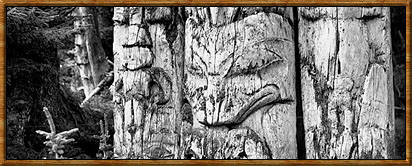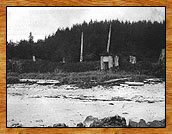 
|
Kiusta

The name Kiusta means "where the trail comes out," in reference to a trail from Lepas Bay to the village. The first European to see the village was Captain George Dixon in July 1787. Kiusta was first portrayed in 1799, in a drawing in the journal of the ship Eliza, a fairly accurate panorama of the town from the water. The largest house belonged to the town chief Itltini, of a branch of the Stastas Eagles whose head chief was Cunnyha (now Gunia) and who is depicted in a sketch by Sigismond Bacstrom. Cunnyha's house was on Lucy Island near Kiusta, but in about 1800 he moved his people to the Prince of Wales Island area of Alaska to join the group known as the Kaigani Haida.
Kiusta, along with the adjacent village of Yaku, was identified by John Work as Lu-lan-na. The remains of twelve houses at Kiusta indicate the population was then just over three hundred people.
The name Edenshaw is first mentioned by fur traders of the 1790s. As with all Haida chiefly names, it was passed down the matrilineal line to a chief's eldest sister's son. At least one Chief Edenshaw preceded the one who dominated most of the nineteenth century, Albert Edward Edenshaw. He was born in 1812 and grew up in his father's village of Rose Spit, but moved to Kiusta after 1834 when he was involved in an unsuccessful attempt to loot the Vancouver, a stranded Hudson's Bay Company ship. The captain and crew blew up the vessel, nearly killing Edenshaw, but he later salvaged many rifles from the sandbar and replaced their badly burned stocks with ones he carved himself. These he traded to other Haida and converted his new wealth into slaves, of which he eventually owned a dozen.
Albert Edward Edenshaw built his house in Kiusta around 1840 after the details of the carvings on the corner posts, rafter ends and frontal pole were revealed to him in a dream. He named it Story House, and it stood on the site of his predecessor's dwelling, called Property House. When Story House was finished, Albert Edward gave a great potlatch and invited guests from Masset, Skidegate, Kaisun and Cha'atl, as well as from Kaigani villages.
The noted artist Charles Edenshaw, who was Albert Edward's nephew and heir, made a model of Story House for John R. Swanton, and it is now at the American Museum of Natural History in New York. Swanton notes that Albert Edward intended to leave Story House to his son rather than his nephew, but abandoned the idea and, in fact, the village itself, moving to Kung village in 1850, just before the capture of the ship Susan Sturgis by Chief Wiah of Masset.
Just west of Kiusta are three mortuary posts that once supported a communal mortuary box, now completely overgrown with mosses and ferns. In 1932, Robert Bruce Inverarity saw these mortuary poles and recorded his observations of them:
The centre pole of the three carved poles was half round, and hollow, while the other two were solid. The two outer poles and the plain pole behind are notched in the top to receive a burial box at a height of about fifteen feet. The box was gone. On both sides of this mortuary group were the remains of burial platforms. Both were broken and well pilfered like the cave we had visited, by fisher folk. From the box sides I found there must have been from twenty to thirty boxes on each side of the two platforms.
Remains of the timbers that formed the burial platforms were still evident in the 1990s. The central pole of this mortuary appears to once have been an interior pole of a chief's house, for the back of it is hollowed out, as Inverarity notes above, and it also has a small oval doorway only a foot (30 cm) high in the base. The opening is clearly symbolic rather than functional, but it is similar to other known examples of interior central poles from the backs of houses; they appear to be thought of as small frontal poles for the chief's compartment.
When Marius Barbeau went to Kiusta for the Canadian Museum of Civilization in 1939, he photographed several monuments there and at Yaku. On my first visit to Kiusta in 1967 to map the village, there was but one other pole left standing, with the face of a Bear on it. This pole was removed to the museum, where a replica was made; the original was then returned to the community museum in Masset.

 |
Yaku village near Kiusta was founded by refugees from the southwest coast of Haida Gwaii who fled their enemies from Skungwai. An epidemic wiped out most of the community in 1852, and the survivors eventually settled at Masset.
Photograph by Charles F. Newcombe, 1913. |

|